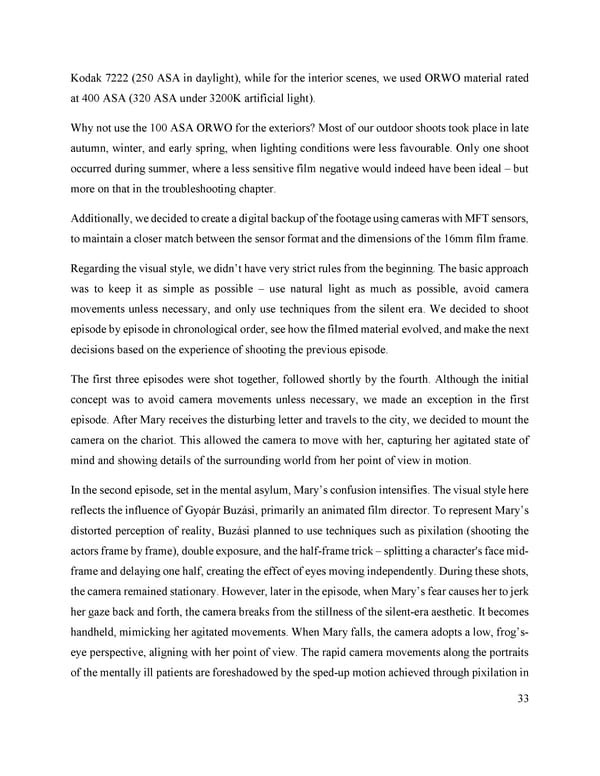Kodak 7222 (250 ASA in daylight), while for the interior scenes, we used ORWO material rated at 400 ASA (320 ASA under 3200K artificial light). Why not use the 100 ASA ORWO for the exteriors? Most of our outdoor shoots took place in late autumn, winter, and early spring, when lighting conditions were less favourable. Only one shoot occurred during summer, where a less sensitive film negative would indeed have been ideal – but more on that in the troubleshooting chapter. Additionally, we decided to create a digital backup of the footage using cameras with MFT sensors, to maintain a closer match between the sensor format and the dimensions of the 16mm film frame. Regarding the visual style, we didn’t have very strict rules from the beginning. The basic approach was to keep it as simple as possible – use natural light as much as possible, avoid camera movements unless necessary, and only use techniques from the silent era. We decided to shoot episode by episode in chronological order, see how the filmed material evolved, and make the next decisions based on the experience of shooting the previous episode. The first three episodes were shot together, followed shortly by the fourth. Although the initial concept was to avoid camera movements unless necessary, we made an exception in the first episode. After Mary receives the disturbing letter and travels to the city, we decided to mount the camera on the chariot. This allowed the camera to move with her, capturing her agitated state of mind and showing details of the surrounding world from her point of view in motion. In the second episode, set in the mental asylum, Mary’s confusion intensifies. The visual style here reflects the influence of Gyopár Buzási, primarily an animated film director. To represent Mary’s distorted perception of reality, Buzási planned to use techniques such as pixilation (shooting the actors frame by frame), double exposure, and the half-frame trick – splitting a character's face mid- frame and delaying one half, creating the effect of eyes moving independently. During these shots, the camera remained stationary. However, later in the episode, when Mary’s fear causes her to jerk her gaze back and forth, the camera breaks from the stillness of the silent-era aesthetic. It becomes handheld, mimicking her agitated movements. When Mary falls, the camera adopts a low, frog’s- eye perspective, aligning with her point of view. The rapid camera movements along the portraits of the mentally ill patients are foreshadowed by the sped-up motion achieved through pixilation in 33
 Lost Analogue: Exploring Film, Music, and Interdisciplinary Methods in Education Page 33 Page 35
Lost Analogue: Exploring Film, Music, and Interdisciplinary Methods in Education Page 33 Page 35